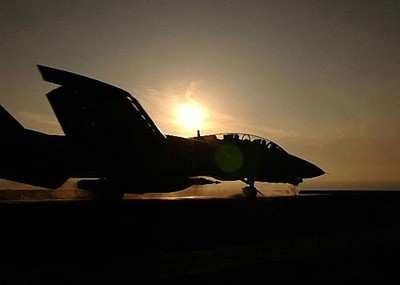Mechanics Perform Last 280-Day Inspections On Show Bird
Fighter Squadron (VF) 32 aviation structural mechanics performed
their last 280-day inspection on their freshly painted F-14 Tomcat
"show bird" by replacing and testing their ejection seats Feb.
27-28.

The squadron is preparing to say goodbye to the F-14 Tomcats as
the squadron nears the end of their deployment embarked aboard USS
Harry S. Truman (CVN 75) later this spring. VF-32 will transition
to the F/A-18 Super Hornet in October.
While the Navy is planning to decommission the birds, it doesn't
stop VF-32's aviation structural mechanics from completing
maintenance with the same diligence and pride they have always
had.
“It’s to ensure the seat is going to work correctly
if the pilot ever needs it,” said Aviation Structural
Mechanic 2nd Class (AW/SW) Travis Holland. “We start by, of
course, de-arming the ejector seats and pulling them out. Then we
break it down to what we call ‘parade rest.’ We do this
to ensure it’s going to work if the pilot ever needs it - to
ensure he’s going to live through a mishap."
Then, the aviation structural mechanics began an extensive
two-day breakdown, maintenance, rebuild and test of both seats in
the aircraft. Holland said this often requires extensive corrosion
control and related maintenance, which will be substantially less
for the Super Hornet, one of the advantages of upgrading to the
platform.
“We check the time-release mechanisms for altitude to make
sure the seat-man separation happens at the proper altitude when
it’s supposed to,” said Holland.

The structural mechanics also remove explosive devices for the
ejection itself, making sure they fire properly, and they test the
release mechanism for yield, so it’s not too difficult for
the pilot to activate the seats if needed.
Since there aren’t any new Tomcat pieces available to the
squadron, discrepancies require all the know-how and craftsmanship
of the mechanics to repair existing parts on site, and sometimes it
takes a whole day to reassemble just one seat.
Once the work is finally done, the seats are craned into the
waiting aircraft and fastened into place. Then they’re
inspected once more before the cockpit hatch lowers for good.
“Hopefully, we do all this work for nothing,” said
Holland, “but if we need it, we’re going to make sure
it’s there to work.”
While there are plenty of other such inspections to come with
any aircraft fitted with ejector seats, the dwindling number of
two-seaters begins to weigh on the minds of the Sailors doing the
work.
“I guess for some of the older Sailors, it’ll be a
sad thing,” said Holland of the forthcoming farewell to
fighters.
Holland added that working on Hornets involves a lot less
corrosion work that significantly cuts back on maintenance
man-hours, allowing some very useful time for command and personal
development, such as warfare qualifications and education.
“I think things will improve overall,” said Holland,
“with time for Sailors to get better at being
Sailors.”
Aside from a little less maintenance on the new platform, some
still don’t know what to expect.

“I’ve never had an ‘end of an
era,’” said Aviation Structural Mechanic 1st Class
(AW/SW) Craig McClure, who has spent 17 years working on Tomcats.
“I can’t say I’m looking forward to it, but once
I’m there, change is not always bad - it’s just
different. It’s sad in a way.”
Only two more of VF-32’s aircraft require another 280-day
inspection before the squadron transitions to the Hornet. From a
maintenance perspective, things are truly drawing to a close for
the legendary Tomcat.
The Harry S. Truman Carrier Strike Group, consisting of USS
Barry (DDG 52), USS Mason (DDG 87), USS Monterey (CG 61), USNS
Arctic (T-AOE 8), USS Albuquerque (SSN 706) and the aircraft from
embarked CVW-3, deployed Oct. 13 for its second deployment in
support of Operation Iraqi Freedom and the global war on
terrorism.
(ANN salutes Journalist 3rd Class (SW) John Stevens, USS
Harry S. Truman Public Affairs)
 Classic Aero-TV: The Switchblade Flying Car FLIES!
Classic Aero-TV: The Switchblade Flying Car FLIES! ANN FAQ: Q&A 101
ANN FAQ: Q&A 101 ANN's Daily Aero-Term (04.12.24): Discrete Code
ANN's Daily Aero-Term (04.12.24): Discrete Code ANN's Daily Aero-Term (04.13.24): Beyond Visual Line Of Sight (BVLOS)
ANN's Daily Aero-Term (04.13.24): Beyond Visual Line Of Sight (BVLOS) ANN's Daily Aero-Linx (04.13.24)
ANN's Daily Aero-Linx (04.13.24)





